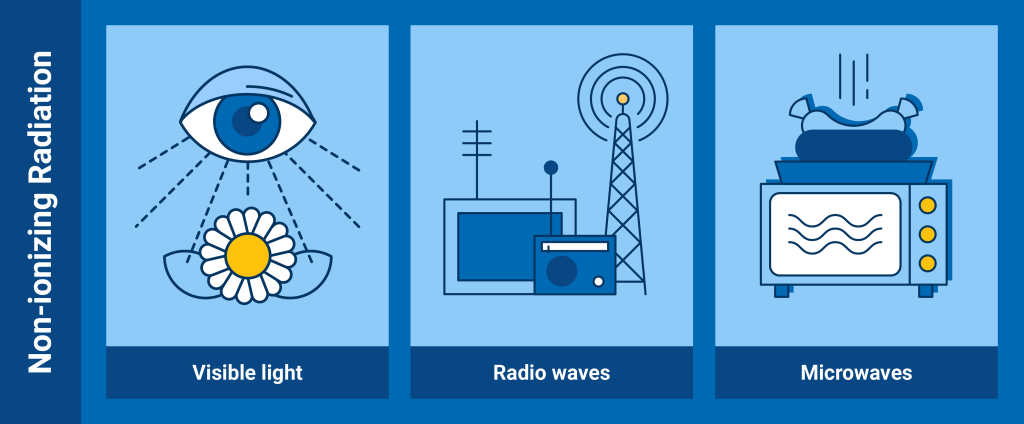Definition of radiation #
Radiation is the release of energy in the form of waves or particles. There are different types of radiation and they have different properties and effects. According to their energy, they are classified as non-ionizing and ionizing radiation.
First of all, there is no such thing as “radioactive radiation.” But as we know from other expressions, even the most obscure and invented words live in wild dressage, and are used extensively in the population.

Non-ionizing radiation #
Non-ionizing radiation is a type of electromagnetic radiation that does not have enough energy to ionize atoms or molecules by removing an electron (negative particle) from an atom or molecule. In other words, non-ionizing radiation has enough energy to move atoms but not create ions.

Visible light #
Visible light is the range of electromagnetic radiation that the eye can perceive. It ranges from lower energies (red light) to higher energies (violet light). Visible light is responsible for our visual perception and is usually harmless to humans.
Infrared radiation #
Infrared radiation has longer wavelengths than visible light and is known to produce heat. It is used in thermal cameras and remote controls. It can produce heat, but is usually not harmful to humans at typical exposure levels.
Ultraviolet (UV) radiation #
Ultraviolet radiation has shorter wavelengths and higher energy than visible light. It comes primarily from the sun and is divided into UVA, UVB and UVC bands. UVC radiation is absorbed by the atmosphere, while UVA and UVB can reach the earth’s surface and affect our skin and eyes. UVA radiation is associated with skin aging, while UVB radiation is the primary cause of sunburn and increases the risk of skin cancer.
Ionizing radiation #
Ionizing radiation is a type that can ionize materials – that is, when it interacts with atoms, it turns the atoms into ions (either with more or fewer electrons than the atom). It is not possible not to be exposed to ionizing radiation, it is a natural part of our world and we are exposed to it daily from both natural and man-made sources.
Ionizing radiation usually comes in three different forms: alpha, beta, and gamma radiation. Each of these has a different composition. The different types of ionizing radiation have different energies, and this affects how far they can penetrate.

Alpha radiation (α) #

Alpha radiation is the emission of large and heavy helium nuclei, because they are very heavy, they do not travel very far, a maximum of only 3-10 cm through the air, before they collide with air particles and are stopped.
They are stopped by very thin materials – for example, something as simple as a piece of paper. Alpha emitters can therefore be stored safely in a sealed container.
When encountered outside the body, alpha radiation is harmless. It is stopped by the body’s outermost, usually dead, layer of skin. It is only if an alpha source were to enter the body, i.e. inhaled or ingested and released inside the body at high exposures, it can cause harm.
Beta radiation (β) #

Beta radiation is the emission of electron or positron radiation. It has a longer range in the air, of about 2 meters before being stopped.
They are stopped by a thin piece of aluminium, wood, clothing or glass a few millimeters thick, and therefore cannot penetrate through walls, or through windows in a house or in a car.
If the energy level is high enough, they can reach under the skin into the body, but not go all the way through. If the amount (i.e. the number of beta particles) is large enough, it can produce an effect similar to sunburn, but slower to heal.
Beta emitters can also be stored safely in suitably sealed containers.
Beta radiation can be useful for medical imaging if they are released by a material injected into the body. They can also be very useful in cancer treatment if you can put the radioactive material in a tumor.
Gamma radiation (γ) #

Gamma radiation is high-energy electromagnetic radiation and is the most penetrating type. It travels several meters in the air before it is stopped. It can be stopped by a thick sheet of lead, a layer of concrete or steel.
Compared to damage from alpha and beta radiation, ingesting a gamma source is not nearly as harmful, since most of the gamma radiation usually simply passes through the body without affecting it.
This is why gamma rays are useful in medicine – to show if bones are broken, or where there are cavities in teeth, or to locate a tumor.




